Themed collection Frontiers in Nanocrystal Surface Chemistry

3D assembly of preformed colloidal nanoparticles into gels and aerogels: function-led design
Nanoparticle-based aerogels combine the properties of traditional aerogels with those of nanoparticles, and hold promise for various applications following a function-led design.
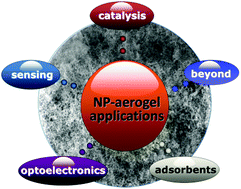
Chem. Commun., 2017,53, 12608-12621
https://doi.org/10.1039/C7CC03862C
Interface control of electronic and optical properties in IV–VI and II–VI core/shell colloidal quantum dots: a review
Core/shell heterostructures provide controlled optical properties, tuneable electronic structure, and chemical stability due to an appropriate interface design.
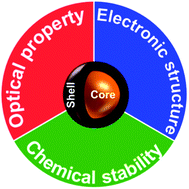
Chem. Commun., 2017,53, 1002-1024
https://doi.org/10.1039/C6CC08742F
Purification technologies for colloidal nanocrystals
Effective and gentle purification methods are essential for describing colloidal nanocrystal surface chemistry, which is key to optimizing nanocrystal technologies.
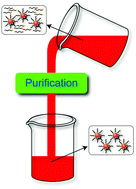
Chem. Commun., 2017,53, 827-841
https://doi.org/10.1039/C6CC07998A
Nearest-neighbour nanocrystal bonding dictates framework stability or collapse in colloidal nanocrystal frameworks
Here we identify order–disorder transitions in porous, mesostructured assemblies of colloidal nanocrystals using quantitative image analysis of assembly outcomes.
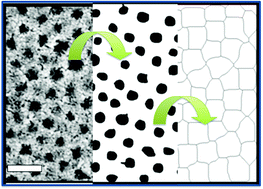
Chem. Commun., 2017,53, 4853-4856
https://doi.org/10.1039/C6CC10183F
Surface chemistry of cadmium sulfide magic-sized clusters: a window into ligand-nanoparticle interactions
Optoelectronic properties of nanoparticles are intimately coupled to the complex physiochemical interplay between the inorganic core and the organic ligand shell.
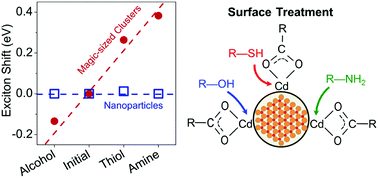
Chem. Commun., 2017,53, 2866-2869
https://doi.org/10.1039/C6CC09549F
The photoluminescence spectral profiles of water-soluble aggregates of PbS quantum dots assembled through reversible metal coordination
PbS quantum dots coupled by glutathione–Zn2+ complexes act as their own aggregation sensors by mediating multi-step near-infrared energy transfer.
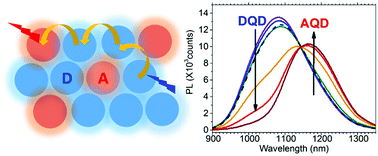
Chem. Commun., 2017,53, 1981-1984
https://doi.org/10.1039/C6CC07950D
Structure, transport and photoconductance of PbS quantum dot monolayers functionalized with a copper phthalocyanine derivative
We simultaneously surface-functionalize PbS nanocrystals with Cu 4,4′,4′′,4′′′-tetraaminophthalocyanine and assemble this hybrid material into macroscopic monolayers.
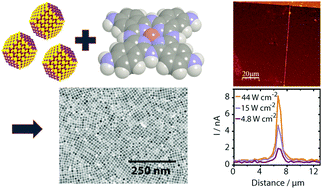
Chem. Commun., 2017,53, 1700-1703
https://doi.org/10.1039/C6CC07878H
On the efficacy of anthracene isomers for triplet transmission from CdSe nanocrystals
Isomeric substitutions on anthracene greatly effects triplet transmission from CdSe nanocrystals.
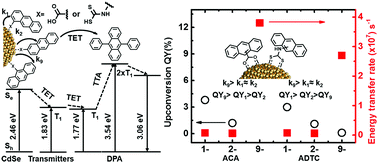
Chem. Commun., 2017,53, 1241-1244
https://doi.org/10.1039/C6CC08229G
Engineering the surface chemistry of lead chalcogenide nanocrystal solids to enhance carrier mobility and lifetime in optoelectronic devices
We develop a hybrid ligand exchange process to enhance both mobility and lifetime of carriers in nanocrystal thin films.
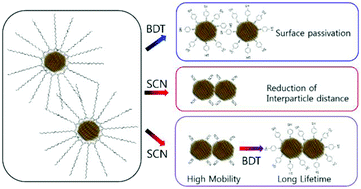
Chem. Commun., 2017,53, 728-731
https://doi.org/10.1039/C6CC07916D
Atomic models for anionic ligand passivation of cation-rich surfaces of IV–VI, II–VI, and III–V colloidal quantum dots
Cation-rich (100) and (111) facets of colloidal quantum dots could be greatly stabilized by dimerization or amine–anion co-passivation.
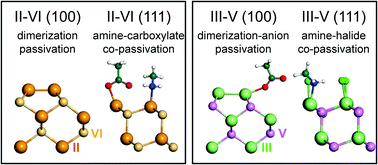
Chem. Commun., 2017,53, 388-391
https://doi.org/10.1039/C6CC07933D
Rh(0)/Rh(III) core–shell nanoparticles as heterogeneous catalysts for cyclic carbonate synthesis
Rh(0)/Rh(III) core–shell nanoparticles, generated by surface oxidation with N-bromosuccinimide, exhibited high activity and excellent recyclability for cyclic carbonate synthesis.
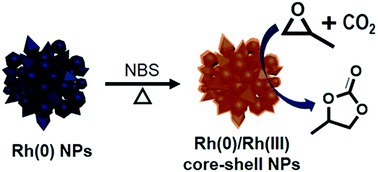
Chem. Commun., 2017,53, 384-387
https://doi.org/10.1039/C6CC08318H
Stabilizing the cubic perovskite phase of CsPbI3 nanocrystals by using an alkyl phosphinic acid
Phase-stable perovskite CsPbI3 nanocrystals have been prepared by replacing conventionally used oleic acid with a phosphinic acid in their synthesis.
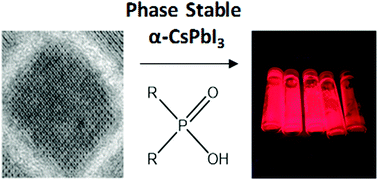
Chem. Commun., 2017,53, 232-235
https://doi.org/10.1039/C6CC08282C
Investigating the role of amine in InP nanocrystal synthesis: destabilizing cluster intermediates by Z-type ligand displacement
The reaction of primary amines with carboxylate-capped InP clusters is found to remove indium carboxylate subunits from the cluster surface, resulting in a structural rearrangement to alleviate core strain and passivate phosphorus atoms.
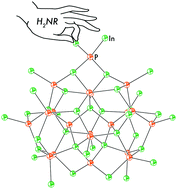
Chem. Commun., 2017,53, 161-164
https://doi.org/10.1039/C6CC07952K
Direct conjugation of antibodies to the ZnS shell of quantum dots for FRET immunoassays with low picomolar detection limits
Direct conjugation of IgG, F(ab′)2, and Fab antibodies to the ZnS shells of penicillamine-coated quantum dots for high-sensitivity FRET biosensing.
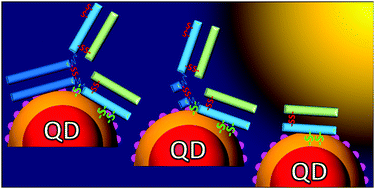
Chem. Commun., 2016,52, 14423-14425
https://doi.org/10.1039/C6CC08835J
Highly efficient three-component coupling reaction catalysed by atomically precise ligand-protected Au38(SC2H4Ph)24 nanoclusters
The Au38(SC2H4Ph)24 nanocluster catalyzes the A3 coupling reaction with a turnover frequency significantly higher than those of conventional nanogold catalysts.
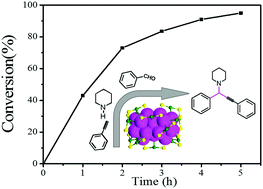
Chem. Commun., 2016,52, 14298-14301
https://doi.org/10.1039/C6CC07825G
In situ spectroscopic characterization of a solution-phase X-type ligand exchange at colloidal lead sulphide quantum dot surfaces
We employed quantitative NMR spectroscopy and spectrophotometric absorbance titration to study a quantum dot X-type ligand exchange reaction.

Chem. Commun., 2016,52, 13893-13896
https://doi.org/10.1039/C6CC08114B
Solution processable formation of a few nanometer thick-disordered overlayer on the surface of open-ended TiO2 nanotubes
Herein, we designed vertically aligned TiO2 nanotube arrays, in which a very thin disordered overlayer approximately a few nm thick was formed via a room-temperature solution process.

Chem. Commun., 2016,52, 13807-13810
https://doi.org/10.1039/C6CC07611D
Composition-dependent surface chemistry of colloidal BaxSr1−xTiO3 perovskite nanocrystals
BaxSr1−xTiO3 perovskite nanocrystals, prepared by the vapor diffusion sol–gel method and characterized by state of the art surface techniques, display significantly different O–H stretching frequencies and adsorption properties towards CO2 as a function of the alkaline earth composition (Ba vs. Sr).
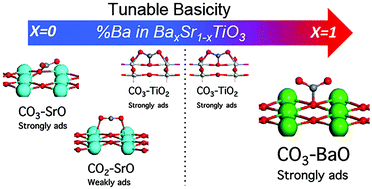
Chem. Commun., 2016,52, 13791-13794
https://doi.org/10.1039/C6CC07298D
The effect of surface capping on the diffusion of adatoms in the synthesis of Pd@Au core–shell nanocrystals
We offer new insights into the roles played by surface capping in controlling the pattern of growth involving Pd cubic seeds and a HAuCl4 precursor.
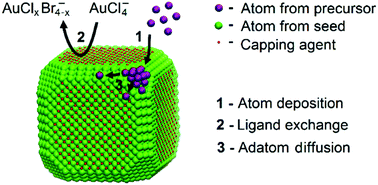
Chem. Commun., 2016,52, 13159-13162
https://doi.org/10.1039/C6CC07456A
Shape-controlled synthesis of CO-free Pd nanocrystals with the use of formic acid as a reducing agent
This paper reports the use of formic acid as a reducing agent for the shape-controlled synthesis of Pd nanocrystals with no chemisorption of CO on the surface, as confirmed by attenuated total reflection Fourier transform infrared (ATR-FT-IR) spectroscopy.

Chem. Commun., 2016,52, 12594-12597
https://doi.org/10.1039/C6CC07055H
Dual-mode crystal-bound and X-type passivation of quantum dots
In this work, we present a new way to understand and influence the properties of quantum dots utilizing surface chemistry.

Chem. Commun., 2016,52, 12214-12217
https://doi.org/10.1039/C6CC05951A
Shape control of zincblende CdSe nanoplatelets
Water matters: the aspect ratio of CdSe nanoplatelets can be precisely tuned by adjusting the fraction of hydrated cadmium acetate in the synthesis.
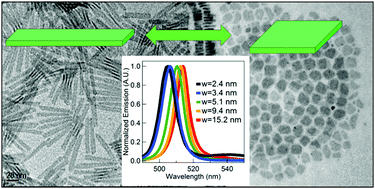
Chem. Commun., 2016,52, 11975-11978
https://doi.org/10.1039/C6CC05705E
Observation of uniform ligand environments and 31P–197Au coupling in phosphine-terminated Au nanoparticles
Phosphine-terminated gold nanoparticles exhibit unexpectedly uniform ligand environments that enable the identification of 31P–197Au coupling for the first time in these systems.
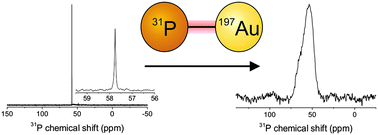
Chem. Commun., 2016,52, 9020-9023
https://doi.org/10.1039/C6CC00464D
High-throughput synthesis and characterization of nanocrystalline porphyrinic zirconium metal–organic frameworks
We describe and employ a high-throughput screening method to accelerate the synthesis and identification of pure-phase, nanocrystalline metal–organic frameworks (MOFs).
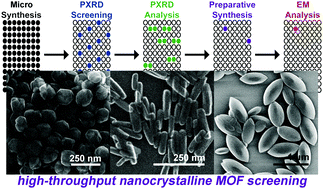
Chem. Commun., 2016,52, 7854-7857
https://doi.org/10.1039/C6CC03264H
About this collection
This web theme aims to collect state of the art work on the surface chemistry of nanocrystalline materials with an emphasis on chemical reactivity, structural characterization, and physical or chemical structure/property relationship. We seek articles that explore nanocrystal structure, the binding of ligands, the influence of ligands on nanocrystal growth, the passivation of defect states by surface ligands, changes in electronic structure by surface ligands, the influence of nanocrystal surface structure on catalytic activity, and interfacial charge transport phenomena.